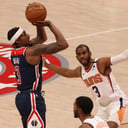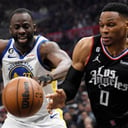Welcome to the defining trade of the BOGO (Bold Owner Goes Overboard) era. In one corner, we have Phoenix’s Mat Ishbia, rapidly jettisoning any asset that isn’t nailed down to overpay for whatever shiny object next appears on the market. In the other, we have Washington’s Ted Leonsis, humbly beginning a long-overdue teardown less than a year after boldly declaring Bradley Beal’s no-trade clause was a “point of partnership.”
Advertisement
Oddly, the partnership became less symbiotic once one of the alleged partners was looking at spending next January in the upper Midwest. The no-trade clause likely cost the Wizards considerable opportunity and leverage, as it severely restricted Washington’s trade options once the franchise reached the inevitable conclusion that it was time to move on.
This conclusion, of course, came three years too late amid much chest-thumping about never tanking, and in the intervening time Beal’s trade value went from a possibly Rudy Gobert-esque return to … not all that much. (In the end, the deal appears to be Chris Paul, Landry Shamet, a few second-round picks and one or two likely irrelevant first-round pick swaps to Washington in return for Beal and Jordan Goodwin. It could still expand to a three-team deal, but that would be the Washington-Phoenix piece of the transaction.)
That the Wizards got a whole lot of not much and still won the trade is a testament to the Suns’ willingness to do Extremely Splashy Things under Ishbia on the heels of already trading Mikal Bridges, Cam Johnson and four unprotected firsts to Brooklyn for Kevin Durant. That trade was at least quasi-defensible on the grounds that only a small handful of players on the planet are capable of winning a playoff series by themselves, and they don’t come available via trade at reliable intervals.
The Beal trade, on the other hand, is a very different beast. Start with the fact that Beal’s contract is likely a negative, even without the no-trade clause that now transfers to Phoenix. He makes $42.5 million this season, at age 30, with a projected BORD$ value of $32.5 million for 2023-24.
He is still a good player, but he is paid like a great one. Between blah defense, injuries and his weirdly disappearing 3-ball, it is a real stretch to rank Beal among the league’s 25 best players. That contract, however, pays him like a superstar until he’s 33, with a $57 million gulp in 2026-27. That’s going to be a difficult number to ever deal if things don’t go well.
Did I mention Beal has a no-trade clause?

GO DEEPER
Bradley Beal trade grades: Instant reaction as Suns form new big 3
I’m also slightly astonished by the Suns’ rush to be rid of Chris Paul. While trading him is at least better than the bonkers idea of cutting him outright, it’s odd how much they soured on his value. Yes, he got hurt in the playoffs, he clearly took a step back in 2022-23 after an All-Star 2021-22 season. He’s 38, and at times, he slows the team down too much. Even so, I’d argue Paul at $30.8 million was not a significantly worse proposition than Beal at $42.5 million, and he doesn’t come with a giant bill for the next four years attached and a no-trade clause.
Advertisement
All of that discussion views the Beal trade in a vacuum. But of course, the Suns do not play in a vacuum. (Though it may seem like it at the rate their future draft picks are disappearing.) Beal, instead, now plays on the same team as Devin Booker … who might be the single most similar player to Beal in the entire league, except Booker is younger and slightly better at pretty much everything.
Inevitably, the presence of Booker (not to mention Durant) will push Beal into something he hasn’t been in a long time, a mostly off-ball spacer who may be looking at a Chris Bosh-to-Miami type decline in his touches. There is only one basketball; the math won’t allow for anything else.
The upside hope is that Beal’s shot profile becomes dramatically more 3-heavy, and more accurate, in Phoenix. It’s not a pipe dream, not when Beal was so reliant on self-created shots in Washington and had much higher 3-point percentages when he had prime John Wall as a set-up man. But it’s not a given, either, and the Suns certainly didn’t address a weakness here.
The Suns will trot out lineups with both Beal and Booker starting, naturally, but that either forces Booker to be a full-time point guard or one of those two to be a full-time wing stopper. LOL on the second one, so look for the Suns to bring back Torrey Craig or look for cheap wing defenders elsewhere to fortify the rotation.
This takes us to the other big-picture takeaway from the Beal trade. Phoenix used perhaps its last realistic trade chip to take a step back defensively and add another offensive player … a perfectly natural reaction to losing a second-round playoff series where the other team averaged 1.22 points per possession and its best player scored 34.5 points per game on 59 percent shooting.
One of the columns I never quite got around to pushing out during the NBA Finals was how, at some level, it was difficult to imitate the Nuggets’ model of success given how idiosyncratic a player Nikola Jokić is. However, the one thing I thought teams would surely copy was the Nuggets’ model of arming themselves with a slew of big wing defenders and essentially taking away opponents’ ability to hunt mismatches along the perimeter.
Advertisement
Especially for a team like Phoenix, which lacked an elite rim protector or pick-and-roll switch specialist, this seemed like the surest way to guarantee decent-to-good defensive outcomes.
Well, the Suns started out with that model and then burned it to the ground to get Durant and Beal. While they didn’t lose any wing defenders in this trade, they lost their ability to add any, which seems just as bad given how asset-starved they are. You wonder if trading Paul for two half-decent wings making $15 million each would have ended up with a better final product for the Suns. (The Suns did at least salvage some cheap production by getting Goodwin in the trade, a rotation-caliber player on a minimum contract.)
There still is a chance for Phoenix to salvage its cap sheet by making a similar one-for-two type move with center Deandre Ayton. However, the odds of that seem slim unless he has a breakout year, as the league doesn’t place a huge value on centers in general and in particular on centers making $30 million a year. It’s hard to see that changing with this trade likely to result in Ayton touching the ball, what, four times a game?
In perhaps the ultimate irony, a Suns team that for years suffered under one of the league’s cheapest owners will now be penalized for the profligacy of the new one. In the absence of a dramatic Ayton transaction this offseason, the Suns are looking at being into the second tax apron for at least the next three years, resulting in a “jailed” future draft pick situation and virtually no flexibility to add players beyond minimum contracts.

GO DEEPER
Hollinger: Clippers, Warriors biggest foes aren't on court, it's the new CBA
There is some KG-to-the-Nets potential down the road here. The Suns have already traded unprotected picks in 2025, 2027 and 2029 to Brooklyn in the Durant trade; if they stay over the second apron in three of the next five years, based on a copy of the incoming CBA’s term sheet obtained by The Athletic, their first-round pick in 2032 may automatically get moved to the back of the draft based on the new CBA rules, even if they have the worst team in the league.
As for Washington, it’s a bittersweet victory. Finally, there seems to be a grander vision in D.C. than aspiring to averageness. On the other hand, the entire Beal saga was a completely preventable own goal. As mentioned above, we are less than one year-removed from Leonsis proudly crowing that Beal’s ridiculous no-trade clause — granted under no duress whatsoever — was something, “I didn’t take as a point of leverage, I took it more as a point of partnership.”
As noted above, the opportunity cost of not trading Beal three years ago and instead chasing the ninth seed a few more times really stings. I can relate from my own personal experience how hard it is to execute an organizational U-turn on something like this. We were probably two years too late on our own rebuild in Memphis and were fortunate that Marc Gasol and Mike Conley still retained most of their trade value once we pulled the trigger. Washington was not as fortunate, and the rebuild will likely be much longer and more painful as a result.
Advertisement
Fortunately, the Wizards may have a chance to win this trade a second time by rerouting Paul to a third team for expiring contracts and/or secondary assets. He had his contract guarantee upped to $25.04 million for this season as a result of this deal; it becomes fully guaranteed at $30.1 million as of June 28.
That should about end any discussion of waiving him; Paul is a far more compelling trade piece as a living, breathing player on an expiring contract at this point. In fact, any analysis of cap room shenanigans is focusing on the wrong player. The Wizards could generate several million in cap room by stretching Shamet’s $10.6 million over seven years, although that play also seems unlikely.
The weird part is that a lot of this will play out in slow motion. I don’t think the Suns added anything to their title odds with this deal, but they are going to be good this year regardless. As with the Durant trade, the pain won’t come until later, but when it hits, it’s gonna hit hard. The BOGO party is always fun while it lasts, but hangovers have no cure.
Related reading
Aldridge: Wizards pay the piper in full with terrible-but-needed trade
Related listening
(Photo of Bradley Beal and Landry Shamet: Christian Petersen / Getty Images)

